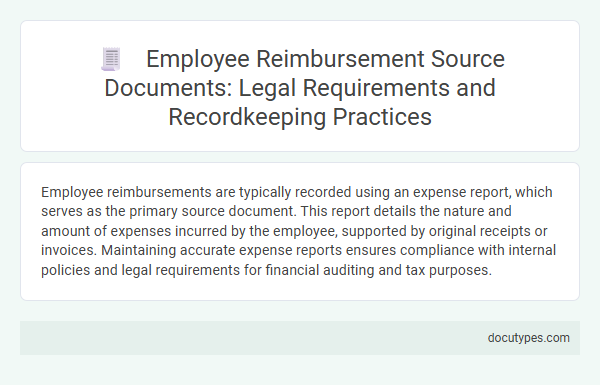Employee reimbursements are typically recorded using an expense report, which serves as the primary source document. This report details the nature and amount of expenses incurred by the employee, supported by original receipts or invoices. Maintaining accurate expense reports ensures compliance with internal policies and legal requirements for financial auditing and tax purposes.
Introduction to Employee Reimbursement and Legal Foundations
Employee reimbursement involves compensating employees for expenses incurred during work-related activities. Proper documentation is crucial to ensure accuracy and legal compliance in the reimbursement process.
Source documents such as expense reports and original receipts serve as primary evidence when recording employee reimbursements. These documents verify the legitimacy of expenses and support audit trails, fulfilling legal requirements. Your organization must maintain these records to comply with tax regulations and internal policies.
Key Legal Requirements for Reimbursement Documentation
Employee reimbursements require accurate source documents to ensure compliance with legal standards. Proper documentation mitigates risks of disputes and audit issues by providing clear proof of expenses.
- Receipts and Invoices - These documents serve as primary evidence for the amount and nature of the reimbursed expense.
- Employee Reimbursement Forms - Forms must include detailed descriptions, dates, and approval signatures as part of internal controls.
- Compliance with Tax Regulations - Documentation must meet IRS or relevant tax authority requirements to validate non-taxable reimbursements.
Types of Acceptable Source Documents
Employee reimbursements are typically recorded using source documents that provide evidence of the expenses incurred. These documents ensure accuracy and compliance with legal and financial regulations.
Common types of acceptable source documents include receipts, invoices, and credit card statements. Detailed expense reports with attached proof of payment also serve as valid records for reimbursement purposes.
IRS and Local Tax Authority Compliance
The primary source document used to record employee reimbursements is the expense report, which must include detailed receipts and payment proofs. Your documentation should comply with IRS guidelines to ensure tax-deductible reimbursement and avoid penalties.
Local tax authorities may require additional forms or specific formats to validate employee reimbursements. Maintaining accurate and fully compliant records helps meet both federal and local regulations efficiently.
Recordkeeping Duration and Retention Policies
Employee reimbursements are typically recorded using expense reports or reimbursement forms submitted by the employee. These source documents are critical for verifying expenses and ensuring compliance with company and legal policies.
- Retention Period - Employee reimbursement records must be retained for a minimum of seven years to comply with IRS regulations and audit requirements.
- Recordkeeping Requirements - Accurate and complete documentation must be maintained to support the validity of reimbursements and to facilitate potential tax or legal audits.
- Data Security - Reimbursement records should be stored securely, either in physical or electronic form, to protect sensitive employee and financial information.
Maintaining proper source documents for employee reimbursements ensures legal compliance and supports accurate financial reporting.
Privacy and Confidentiality in Document Management
The primary source document used to record employee reimbursements is the expense report, which details the costs incurred by the employee. Maintaining privacy and confidentiality in managing these documents is crucial to protect sensitive financial and personal information. Secure storage methods, access restrictions, and data encryption help ensure compliance with legal and organizational data protection standards.
Penalties for Inadequate Recordkeeping
What source document is used to record employee reimbursements? A reimbursement form or an expense report is typically used to document employee expenses accurately. Properly maintaining these records is crucial to avoid penalties for inadequate recordkeeping.
What are the penalties for inadequate recordkeeping of employee reimbursements? Failure to provide accurate and complete source documents can result in fines and audits by tax authorities. You may face legal consequences if your reimbursement records do not comply with regulatory standards.
Best Practices for Secure Storage and Retrieval
| Source Document for Employee Reimbursements | Expense Reports |
|---|---|
| Description | Expense reports itemize business-related expenses incurred by employees. They serve as primary documents for reimbursement claims, containing details such as date, amount, purpose, and receipts. |
| Best Practices for Secure Storage |
|
| Best Practices for Efficient Retrieval |
|
Digital vs. Physical Source Documents: Legal Considerations
Employee reimbursements are typically recorded using source documents such as expense reports, receipts, or invoices. Legal considerations require that these documents maintain accuracy and authenticity, whether in physical or digital form. You must ensure compliance with data retention laws and security standards when managing digital source documents to avoid potential legal risks.
What Source Document Is Used to Record Employee Reimbursements? Infographic

